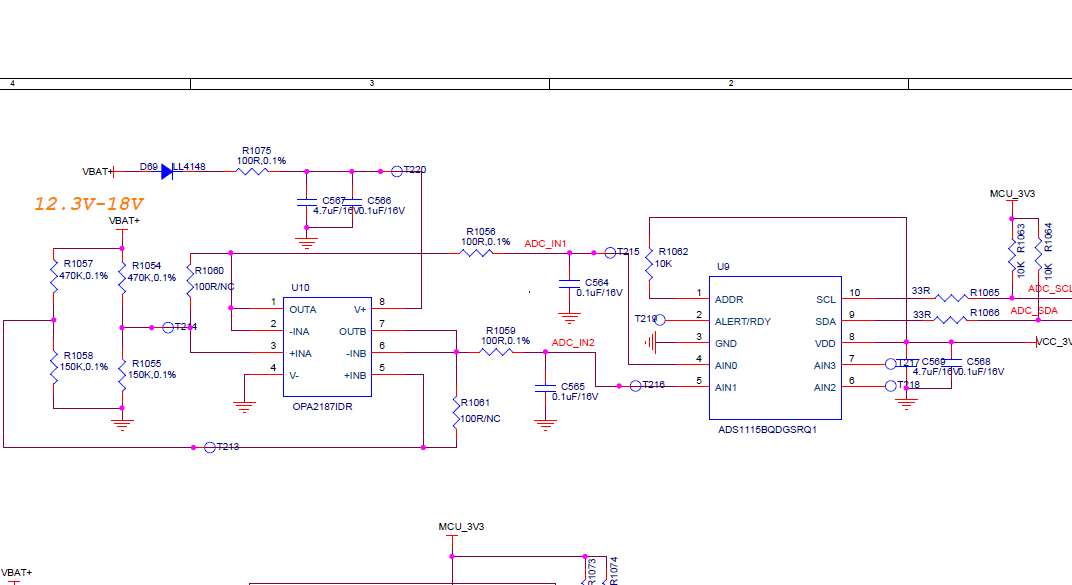Other Parts Discussed in Thread: ADS1115, OPA2187
Hi Team,
My customer now use ADS1115-Q1 and read the output value is 0.When reading the voltage, they only use three functions:
- Ads1115_Config();
- Ads1115_PointRegister();
- VOL=Ads1115_ReadData()
Could you please give some advice?
/************************************************************
FileName: bsp_iic.h
Author: liamtsen
Date: 2019/03/07
Description: IIC����
***********************************************************/
#include "global.h"
//IO��������
#define ADC_SDA_IN() SystemIoModeSetIn(GPIOB,RCC_AHB1Periph_GPIOB,GPIO_Pin_11)
#define ADC_SDA_OUT() SystemIoModeSetOut(GPIOB,RCC_AHB1Periph_GPIOB,GPIO_Pin_11)
#define ADC_SCL_OUT() SystemIoModeSetOut(GPIOB,RCC_AHB1Periph_GPIOB,GPIO_Pin_10)
//IO��������
#define ADC_SCL_H GPIO_SetBits(GPIOB, GPIO_Pin_10) //SCL
#define ADC_SCL_L GPIO_ResetBits(GPIOB, GPIO_Pin_10) //SCL
#define ADC_SDA_H GPIO_SetBits(GPIOB, GPIO_Pin_11) //SDA
#define ADC_SDA_L GPIO_ResetBits(GPIOB, GPIO_Pin_11) //SDA
#define ADC_READ_SDA GPIO_ReadInputDataBit(GPIOB, GPIO_Pin_11)
//ʱ���õ�48M��һ����������1/48000000s
void ADC_delay_us(u32 time)
{
u32 delay=0;
while(time>0)
{
for(delay=0;delay<48;delay++);
time--;
}
}
//��ʼ��IIC
void ADC_I2C_Init(void)
{
ADC_SDA_OUT();
ADC_SDA_H;
ADC_SCL_OUT();
ADC_SCL_H;
}
//����IIC��ʼ�ź�
void ADC_Start(void)
{
ADC_SDA_OUT();
ADC_SDA_H;
ADC_delay_us(4);
ADC_SCL_H;
ADC_delay_us(4);
ADC_SDA_L;
ADC_delay_us(4);
ADC_SCL_L;
ADC_delay_us(4);
}
//����IICֹͣ�ź�
void ADC_Stop(void)
{
ADC_SDA_OUT();//sda�����
ADC_SDA_L;
ADC_delay_us(4);
ADC_SCL_H;
ADC_delay_us(4);
ADC_SDA_H;
ADC_delay_us(4);
}
//�������ݺȴ�Ӧ���źŵ���
//����ֵ��1������Ӧ��ʧ�ܣ�IICֱ���˳�
// 0������Ӧ��ɹ���ʲô������
u8 ADC_Wait_Ack(void)
{
u8 ucErrTime = 50;
ADC_SDA_OUT();//sda�����
ADC_SDA_H;
ADC_delay_us(4);
ADC_SCL_H;
ADC_delay_us(4);
ADC_SDA_IN();
while(ADC_READ_SDA)
{
ucErrTime --;
if(!ucErrTime)
{
ucErrTime = 0xff;
break;
}
}
ADC_SCL_L;
ADC_delay_us(4);
return(ucErrTime);
}
//����ACKӦ��
void ADC_Ack(void)
{
ADC_SDA_OUT();
ADC_SDA_L;
ADC_delay_us(4);
ADC_SCL_H;
ADC_delay_us(4);
ADC_SCL_L;
ADC_delay_us(4);
}
//������ACKӦ��
void ADC_NAck(void)
{
ADC_SDA_OUT();
ADC_SDA_H;
ADC_delay_us(4);
ADC_SCL_H;
ADC_delay_us(4);
ADC_SCL_L;
ADC_delay_us(4);
}
//IIC����һ���ֽ�
//���شӻ�����Ӧ��
//1����Ӧ��
//0����Ӧ��
void ADC_Send_Byte(u8 txd)
{
u8 t = 8;
ADC_delay_us(4);
ADC_SDA_OUT();
while(t--)
{
if((txd&0x80)!=0)
ADC_SDA_H;
else
ADC_SDA_L;
ADC_delay_us(4);
ADC_SCL_H;
ADC_delay_us(4);
ADC_SCL_L;
ADC_delay_us(4);
txd<<=1;
}
}
//��1���ֽڣ�ack=1ʱ������ACK��ack=0������nACK
u8 ADC_Read_Byte(void)
{
unsigned char i,receive=0;
ADC_SDA_IN();
for(i=8;i!=0;i--)
{
ADC_SCL_H;
ADC_delay_us(4);
receive<<=1;
if(ADC_READ_SDA)
receive|=0x01;
else
receive&=0xFE;
ADC_SCL_L;
ADC_delay_us(4);
}
return(receive);
}
void Ads1115_Config(void)
{
ADC_Start();
ADC_Send_Byte(0x92);
ADC_Wait_Ack();
ADC_Send_Byte(0x01);
ADC_Wait_Ack();
ADC_Send_Byte(0x84);
ADC_Wait_Ack();
ADC_Send_Byte(0x83);
ADC_Wait_Ack();
ADC_Stop();//����һ��ֹͣ����
ADC_delay_us(200);
}
void Ads1115_PointRegister(void)
{
ADC_Start();
ADC_Send_Byte(0X92); //����������ַ0X30,д����
ADC_Wait_Ack();
ADC_Send_Byte(0x00); //���͵͵�ַ
ADC_Wait_Ack();
ADC_Stop(); //����һ��ֹͣ����
ADC_delay_us(200);
}
u16 Ads1115_ReadData(void)
{
u8 ReadDataBuf[5];
u16 ADtemp;
ADC_Start();
ADC_Send_Byte(0X93); //����������ַ0X30,д����
ADC_Wait_Ack();
ReadDataBuf[0] = ADC_Read_Byte();
ADC_Ack();
ReadDataBuf[1] = ADC_Read_Byte();
ADC_NAck();
ADC_Stop(); //����һ��ֹͣ����
ADC_delay_us(200);
ADtemp = ReadDataBuf[0];
ADtemp <<= 8;
ADtemp += ReadDataBuf[1];
return(ADtemp);
}



